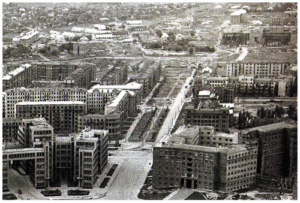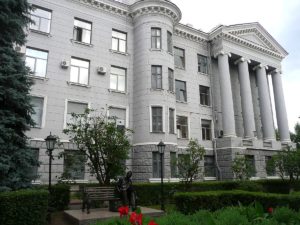Overview on Lenin Avenue, in 1941. On the right (third) is the building of the Engineering and Construction Institute, from which the history of KNURE began. |
In 1947, the Kharkov Mining and Industrial Institute was transformed into the Kharkov Mining Institute (KMI), which in 1962 became the Kharkov Institute of Mining Engineering, Automation and Computer Science (KHIGMAVT). On the basis of one of the faculties of KHIG was converted into the Kharkov Institute of Mining Engineering, Automatics and Computer Science, which soon became one of the first in the former USSR to train specialists in the field of automation, telemechanics and computer science. In 1963, the Institute established the Faculty of Computer Science, which organized a profiling department “Radio Receivers”, which trained engineers in the specialties of “Radio Engineering”, “Design and technology of radio equipment”, “Radiophysics” and “Industrial Electronics”. The department was headed by the Gubernatorov Oleg Ilyich, associate professor, Candidate of Technical Sciences, graduate of the Radio Engineering Department of the Kharkiv Polytechnic Institute. One of the first main engineering disciplines was “Amplifying devices” and “Radio receivers”. At that time there were only 7 full-time teachers at the department. In 1969, at the department of “Radio Receivers” was begun training of scientific personnel of the highest qualification in the postgraduate study. The first post-graduate students were A.N. Zelenin (Scientific Director of Associate Member of the Gubernatorov O.I.), graduate of the Kharkov Polytechnic Institute in 1969 V.I. Shkvyrya (Scientific Director of Associate Member of the Academy of Sciences A.A. Pismenetskyi), and already in 1972 he successfully defended his first thesis for the degree of Candidate of Technical Sciences. Creation and systematization of the base of scientific and methodical literature on these specialties became evidence of the development and validity of the scientific school, which was headed by Associate Professor of Gubernatorov O.I. The main scientific and practical results on design and development of digital frequency synthesizers on the basis of FAPH were summarized in the monograph of Gubernatorov A.I. and Sokolov Yu. “Digital frequency synthesizers of radio engineering systems”. Due to significant scientific and methodical work the department became one of the leading in the university in the field of scientific and methodical support of the educational process. In 1975, the department was headed by an associate professor. Presnyakov I.N., who also paid great attention to the development of the department, the creation of modern material and technical base of the department equipment, increasing the scientific potential and education of specialists of the highest category. The chair has taken leading positions in institute on the organization of laboratory workshops on the basic disciplines which were spent by a face-to-face method – the most progressive method of carrying out of laboratory employment. Universal laboratory models on disciplines “Amplifying devices” and “Radio receiving devices” were developed and made by V.V. Yemelyanov V.V., Zelenin A.N., Associate Professor P.D. Botsman, Associate Professor Presnyakov I.N. and many others. Ideas which have been put in a basis of work of these breadboard models, were progressive, and further became the basic base for development of laboratory practical work of variety of modern disciplines of faculty, namely: “Fundamentals of Circuitry”, “Theory of Electrical Circuits and Signals”, “Theory of Electrical Communication”. Laboratory models with amplifying and receiving devices were exhibited at the republican exhibition of the Ministry of Higher Education of the Ukrainian SSR “Methodology – 84” in Kiev, where they were awarded prizes.
Laboratory work, 1970s
In 1975, the first enrollment of students for the specialty “Multichannel Telecommunications” was carried out at the Radio Engineering Department. The chair started to conduct all kinds of classes on the disciplines of fundamental training of communication specialists: “Theory of Signal Transmission”, “Theory of Electrical Communication”, “Amplifying Devices of Transmission Systems” and “Radio Receivers”. The Department of “Radio Receivers” became one of the first in the Soviet Union, where a new scientific direction – digital synthesis of frequencies and signals – began to develop intensively. In 1976 a branch research laboratory of instrument-making of the Ministry of General Machine Building of the USSR was organized at the department. At the same time, the department continues to establish and maintain close scientific and business contacts with many leading research, design, production and training centers of the Soviet Union, such as Irpa, Leningrad; Research Institute of Radio Communications and UFNDIIT, Kharkov; Moscow Electrotechnical Institute of Communications; Moscow Power Engineering Institute; Research Institute of Instrument Engineering, Moscow; Shevchenko Plant, Kharkov, etc. Research samples of digital frequency synthesizers, which were developed by the staff of the department, as well as the results of scientific research were introduced into industrial development of receiving and transmitting mobile radio communication systems and specialized measuring systems. During this period, a new scientific direction of the department “Digital Signal Processing” is being developed at the department. Within the framework of this scientific direction under the direction of I.N. Presnyakov the theoretical researches and practical developments on creation of new methods of statistical processing of signals and specialized processors for the decision of a wide range of applied problems in radio engineering systems of different purposes have been developed. The department management establishes relations with domestic and foreign scientific organizations, including the Radio Engineering Institute of the USSR Academy of Sciences, the Polar Geophysical Institute of the USSR Academy of Sciences, the Institute of Arctic and Antarctic Sciences of the USSR Academy of Sciences, the Research Institute of Radio Measurements, the Institute of Marine and Polar Research named after M.V. Lomonosov, the Institute of Marine and Polar Research of the USSR Academy of Sciences. Alfred Wagner (Germany), Norwegian Polar Institute, Canarctic State Enterprise (Canada). The Chair’s research team participated in several international scientific programmes and international scientific expeditions at that time. The most important results of scientific research have been put into practice to solve important economic problems. In particular, the hardware and software complex for receiving and forming radiophysical images developed at the Department became an integral part of the reception complex of the Center for Long-Term Space Communications (Evpatoria). It was used to create a new technology for obtaining geophysical images from the first Ukrainian satellite Sich-1. Developments in this area were introduced to equip the dispatch offices of the communications services of a number of regional energy companies in Ukraine. In the early 80s, with the arrival at the Department of Associate Professor V.A. Omelchenko and his team, the scientific direction “Methods of presentation and processing of random signals and fields” (scientific supervisor Associate Professor V.A. Omelchenko) is also developing. Within the framework of this direction, important scientific results were obtained, which became an important aspect of holding a number of All-Union and International Scientific Forums in this direction on the basis of KNURE. In 1984 the All-Union Scientific and Technical Seminar “Statistical methods of signal processing” was held. Since 1985 on the basis of the Kharkov Institute of Radioelectronics the All-Union Scientific and Technical Conference (in the following years – school-seminar) “Methods of representation and processing of random signals and fields” was held annually. Subsequently, in 1991, one of the important scientific directions of this conference was the beginning of an independent scientific forum and an international symposium “Probabilistic models and signal and field processing”. The formation of this scientific direction also influenced the development of the educational process. Its main provisions were used in the development of new academic disciplines “Probabilistic models of signals and fields” and “Special sections of mathematics”. Also 5 manuals on probabilistic models of signals in telecommunications, the first in Ukraine textbook “Theory of Electrical Communication” in three parts and the collective monograph “Theory of Random Processes” of leading scientists of Ukraine and other countries were published. Introduction of new specialties and expansion of the scientific school of the department caused changes in the name of the department. Thus, in 1990, the department was named “Signal Reception and Processing”, in 1999 – has become a department of “Communication Networks”, and, since 2017, the department is called “Information Networking Engineering”, which summarizes the historical development of electrical communications and modern dynamic formation of network systems in the leading field of IT-technologies. In 1995 on the basis of three departments “Multichannel Telecommunications”, “Signal Reception and Processing” and “Radio Measurement” the faculty “Telecommunications and Measuring Technology” was organized. The department “Signal reception and processing” became profiling on preparation of students on specialities “Communication networks” and “Information protection in telecommunication systems”, and since 1998 – on a speciality “Information communication networks”.
KNURE, 2011 In May 2009, Professor Bezruk Valery Mikhailovich, Doctor of Technical Sciences and Academician of the International Academy of Communications, was elected Head of the Department of “Communication Networks”. With the new head of the department “Information-networking engineering” continues the development of existing and new areas of research in the field of telecommunications, strengthening the staff of highly professional specialists, teaching modern specialized disciplines in the expansion and development of info-communication systems, changes in technological processes, the introduction of innovative education systems. |




